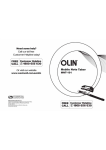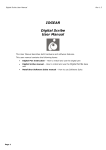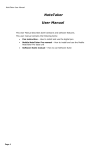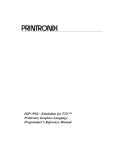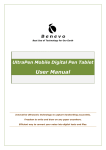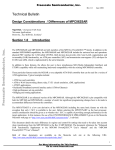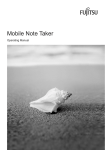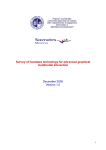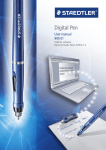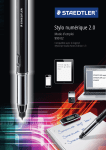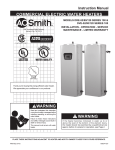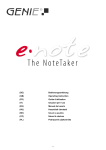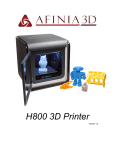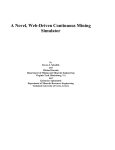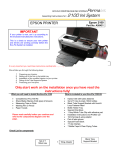Download User Manual
Transcript
User Manual General Overview The digiscribble is a unique device that captures handwritten notes on plain paper, stores the notes to memory and uploads them to a PC. The device consists of a Digital Pen and a small receiving unit. digiscribble uses a patented technology combining Ultrasound and Infrared technologies with sophisticated algorithms to enable an accurate tracking and positioning system that tracks the movement of the tip of the pen on any surface and converts the movement into a vector image of the user’s handwriting. digiscribble can capture and store up to 50 A4 pages. At home or in the office, you can connect the digiscribble to the PC using the USB cable, then upload and manage the saved notes. This User Manual describes both hardware and software features. This user manual contains the following items: • Digital Pen instruction – How to install and use the digital pen Page 2 • Mobile Unit Manual – How to install and use the Digiscribble base unit Page 4 • Software Suite Manual – How to use the Software Suite Page 11 • MyScript Recognition Software – Recognition Training Instructions Page 43 • Client Diagnostics Tool – For reporting technical issues Page 48 Private & Confidential Page 1 1.) Digital PEN User Guide Overview Your Pen is a unique device that captures notes handwritten on plain paper, and transmits them to the base unit. The Pen Uses patented technology combining Ultrasound and Infrared technologies with sophisticated algorithms to enable an accurate tracking and positioning system that tracks the movement of the tip of the pen on any surface and converts the movement into a vector image of the user’s handwriting. Setting up Your Pen Warning: Do not attempt to open the Digital Pen in the middle this will cause the pen to malfunction and invalidate the warranty. Installing/Replacing an Ink Refill into the Pen The top of the pen cap also functions as an ink refill extractor. NOTE: Make sure you use a refill that is similar to the original (standard refill (67.0mm long X 2.35mm diameter). To insert a new refill 1. Slide the new refill into the tip of the pen 2. Gently press the new refill until it is lodged securely in place To replace/remove the ink refill 1. Detach the cap from the digital pen 2. Place the ink refill in the middle of the extractor. Hold the pen firmly, and apply pressure with the extractor against it. Private & Confidential Page 2 3. Pull the used refill out. Installing/Replacing Pen Batteries 1. Please use the enclosed GP SR41 batteries with the positive polarity facing up 2. Batteries may be safely disposed of in normal household waste Contact your local government for disposal or recycling practices in your area 3. Caution: Risk of explosion if battery is replaced by an incorrect type Please use silver oxide button cells battery type only. When your Pen battery runs low, the following message appears on your screen: This warning is continuously displayed on each new note and the application tray icon in the system tray changes to reflect the current status until the batteries are replaced. Tray icon indiocation, for Pen low battery, in Note Mode Note: Lifetime of the batteries may vary and cannot be good for initial use only. • Remove the battery compartment cover • Install two SR41 batteries, with the positive poles • Replace battery compartment cover Private & Confidential Tray icon indiocation, for Pen low battery, in Mouse Mode guaranteed. Supplied batteries are facing up Page 3 2.) Setting Up Your digiscribble Your hardware includes the digital pen and the memory unit. Before you begin working with your Digiscribble, make sure that there is an ink refill and batteries in the pen. (See Section 1) Setting up Your Memory Unit Batteries in the memory unit Please not that you need to fully charge the memory unit must be charged for 3.5 hours before use. Your Digiscribble includes a rechargeable internal battery. Each time you connect your unit to your PC USB port, the batteries are being charged. Full charge time takes 3.5 hours Memory Unit The memory unit consists of an LCD for status indications. The memory unit also consists of a single button allowing you to turn the unit ON and OFF, as well as creating a new file Memory Unit LCD Use the LCD to view status indications. Private & Confidential Name On when Off When Blinks When Digiscribble is Connected Unit is connected to PC Unit is NOT connected to PC Data is uploaded to PC Memory FULL Digiscribble Unit Memory is full Less than 90% capacity used Never Page 4 Pen Low Battery Low Pen battery Pen Battery good Low Pen battery Base unit Low battery Full Unit is Off Charging Note Mode Pen down/Pen move Mouse Mode Pen down/Pen move Mouse Mode Pen down/Pen move Pen Mode Pen down/Pen move Number of saved notes in memory Always Unit is Off Memory full Or Error Memory Unit Connector Use the Digiscribble’s mini USB connector to plug in the USB cable (included in the package), which connects the unit with the PC when uploading notes. Memory Unit Cable Note: Only use the USB cable supplied with your Digiscribble package. The USB cable (included in the package) plugs into the Memory Unit Connector and is used for the following: Uploading notes from the memory unit to the PC Working in Connected Mode (Please see below) Firmware updates (Please see below) Power Save mode (in mobile Mode) In order to save power from the rechargeable battery, while in mobile mode, if there is no activity (Meaning: No Pen usage nor key press on base unit), your base unit will automatically shut down in 10 minutes. Your note will be automatically saved. To exit power save mode, simply press the base unit top button to turn it on. Note: This will start a new Note (File) Mounting your Base Unit to Paper Your base unit can be mounted in 3 positions on top of the paper. (Please Note that when working in Vista Mouse/Tablet mode you must position your unit in the top centre position, as per sketch 2 below) The following images illustrate the way you can mount your base unit, according to the recommended positioning. Private & Confidential Page 5 a. Mounting your base unit at the top center of the paper is recommended for a single paper usage b. Mounting your base unit at the top left corner of a paper block is recommended for right hand Users (Only for use in Pen Mode) c. Mounting your base unit at the top right corner of a paper block is recommended for left hand Users Private & Confidential Page 6 Base Unit Coverage area The following images illustrate the coverage area of your base unit. Note: • The paper is an A4 size paper • The striped line illustrates the covered area in each of the positions • When working in Vista/Mouse Mode you must align your unit at the top centre Base unit located at the left corner Base unit located at the top center Base unit located at the right corner Taking notes away from your PC Simply place your base unit on top of any paper (Up to A4 size) and start writing using your Digital Pen. To save your note, press the button on top of the base unit Private & Confidential Page 7 Connected Mode While connected you can… • Upload your notes to your Note Manager PC application • Take notes On-Line • Use your pen as a mouse Work as Tablet PC Pen compatible In Windows Vista Swap between Pen and Mouse (With Windows Vista only) To swap between Pen & Mouse, simply click your pen tip on the paper, around the area in front of your base unit, as illustrated in this image. Alternatively, you can press the button on top of the base unit Note: Available while connected to your PC only While working with your mouse, place your pen behind the base unit Private & Confidential Page 8 3.) Software Suite Manual General Overview In connected mode (Please see below) most of the functions and features are the same; However, there are some special features to be used only with the Digiscribble in Connected Mode. Those features are marked with (*) System Requirements Microsoft ® Windows 2000 (SP4) or Microsoft ® Windows XP (SP2) or Microsoft ® Vista Minimum 50MB available hard disk space Minimum 128MB RAM 32 bit color quality Screen resolution of 1024x768 pixels Available USB port. o o o o o o Setting Up Your Desktop Software Your product is packaged with a CD that includes its companion desktop software Installing the Software st After the installation, when running the application for the 1 time, a new folder named “My Notes,” is created in your “My Documents” directory. All your notes will be saved into this directory. In the event that no “My Documents” directory is found, the installation will create a new “My Documents” folder on your C hard drive. The ‘My Notes’ folder will be created in this directory. If you uninstall, upgrade or reinstall the software in a different location, the note files will remain in this directory, and will not be overwritten To install Digiscribble software 1. Insert the installation CD into your CD ROM drive. The setup gram should start 2. automatically. If not, run the gram by selecting ‘Run’ from the Windows ‘Start’ menu and type in D:\setup.exe. If your CD drive uses a different letter, type that letter instead of D. Follow the instructions on the screen. During installation, you will be prompted to choose whether you would like the application to auto-start when windows loads, and whether you would like an application icon on your desktop (in Custom Installation). Setting your base unit orientation preferences (Mobile Unit Note Mode Only) Your base unit can be placed in 3 positions, on the top center of an A4 paper, or at the Left/Right corners Recommended for a single paper usage Private & Confidential Recommended for usage on a paper block, for Right Handed Users Recommended for usage on a paper block, for Left Handed users Page 9 Selecting Pen Modes Digiscribble supports a Note/Pen mode and a Mouse/Tablet Mode (Vista Only) Selecting default mode can be done in 2 ways: a. At the first time you start your Digiscribble application OR b. Using the Digiscribble ‘Configuration’ menu (‘Set Digital Pen Mode’) Changing modes during operation can be done in 2 ways: a. Press the base unit top button (‘Mode’ button) OR b. Right click the ‘PC Pen’ tray icon, and change mode OR c. Clicking on the virtual area using your pen Note: On each mode change, a Balloon will popup indicating the current mode and the corresponding LED will lit Using your Pen in Mouse Mode In Mouse mode, your Digital pen behaves as a mouse. Your pen will have the following functionality: • To move your mouse cursor you can hover with the pen. To start Hovering you can press the side button or tip the pen on the paper. The pen will now hover even with no press for about 30 seconds. • To click an object, point your mouse cursor on that object. Now tip the pen on the paper or click the side button • To Double-Click an object, point your mouse cursor on that object. Now tip the pen twice on the paper or click the side button twice • To Right-Click an object, point your mouse cursor on that object. Now press the tip of the pen a bit longer on the paper. A special ‘Right Click’ cursor will appear. Lift the pen from the paper, and the context menu (Right Click menu) appears. Please note you must align the unit top centre of the page for it to use the Vista Tablet or Digital ink features. (*) Uploading Notes to your PC When in Connected Mode, you can upload all your notes from the memory unit to your PC using the Digiscribble software application. Before doing so, first make sure that: Your PC software application is running Private & Confidential Page 10 Your memory unit is connected to your PC’s USB port using the memory unit USB cable The “CONNECTED” icon will be displayed on your memory unit LCD Application Tray Icon will change while uploading your notes: To upload notes • • 1. Start the Note Manager 2. In the ‘File’ menu, select ‘Upload’. All the notes in your memory unit are uploaded to your PC. 3. At the end of the upload, a message appears asking if you want to delete all notes on the memory unit. Select ‘Yes’ to erase all notes on your memory unit. Select ‘NO’ to retain the notes. NOTE: a. When you select ‘NO’, the next time you upload those notes that are already uploaded to the PC Will not be uploaded. b. However, if you delete notes from the PC application and then upload again from the memory unit, the notes will be uploaded again. c. You can select one of three options to be performed automatically when your Digiscribble base unit is connected. The following can be selected in the ‘Configuration -->Preferences’ menu within the Note Manager Upload new notes automatically options: • • • YES – Your Mobile Notes will be automatically uploaded each time you connect it to your PC NO – Your Mobile Notes will not be uploaded. In this option, you will manually need to perform this action by selecting ‘File -->Upload’ menu within the Note Manager ASK ME – Each time you connect the digiscribble base unit, you will be asked if you want to upload your notes Private & Confidential Page 11 (*) Using the Mobile Digiscribble in Connected Mode Your Digiscribble can also be used while connected to your PC. Port Auto-Detection Once you launch the application, the Digiscribble software automatically detects your hardware. The application automatically searches all ports in order to detect the hardware. If it is unable to locate the connection, the Hardware Detection dialog box appears. USB Hot-Insertion USB Hot Insertion refers to connecting the USB cable while the application is running. The application will auto-detect your hardware if the USB cable is disconnected while the system is running and then re-connected. The application will also auto-detect the hardware if you first run the software and then connect the USB cable. (*) When you plug in your Digiscribble unit (If the application is running), you will be asked if you want to upload your notes from the Mobile unit memory to your Note Manager software. Creating Notes The moment you begin to write or sketch with your digital pen, a Note Window appears on your screen that reflects everything that you write on the paper attached to the base unit. The Note Window toolbar allows you to perform various basic functions such as saving, editing, sending and copying your notes while writing, or once you have finished writing. NOTE: While writing, make sure not to block the line of sight between the pen and the base unit with your hand. When the line of sight is blocked, the Digiscribble will not function properly. The following table contains all buttons available in the Notes toolbar together with a description of their functions. Button Description A4 VIEW – Switches the note view to A4 size Memo-size View – Switches the note view to memo size Private & Confidential Page 12 EDIT – Opens the Note Editor for editing the note COPY – Copies the note to the clipboard for pasting into other applications CLEAR – Clears the entire on-screen note UNDO – Clears the previous stroke made by the digital Pen in reverse chronological order. REDO – Replaces previously undone strokes in chronological order NOTE COLOR – Changes the current note color. PEN STYLES- Changes the Ink color and width. SAVE TO FOLDER – Saves the note to a specified folder and closes the note window. SEND BY NETWORK – Sends the current note by local network to selected recipients PRINT – Prints the current note EXPORT TO JPEG- Exports the selected note to a JPEG file SEND BY EMAIL - Sends the current note by email to selected recipients as a JPEG attachment Convert your note to Text using MyScript® Notes CLOSE WITHOUT SAVING – Closes the current note without saving SAVE AND CLOSE – Closes the current note and saves it into the Notes Manager under the default Miscellaneous folder (the note is named according to the creation date) Saving Notes Notes can be saved at any time during the note creation process. They are automatically saved to the default and named according to the date they were created. Notes can be renamed at any time once they have been saved. To save a note In the Note Window Toolbar, click the Save and Close icon save the note to the default Miscellaneous folder click the Save the Folder icon you select to to save the note to any folder NOTE: It is also possible to configure an 'Auto-Save' feature. That will automatically save your note periodically while you are working Private & Confidential Page 13 Printing Notes A note can be printed from any of the 3 Note interfaces – The Note Window, The Note Editor or the Note Manager. Notes can be printed from a saved file in the Note Manager, or while they are open in the Notes Window or Notes Editor. To print a note from a file • • • In the Note Manager, click the note name or thumbnail In the File menu, select Print Preview to first see how the note will look when printed. Note: You can preview multiple notes simultaneously. Select the first note, then on the keyboard press the <CTRL> key and select the other notes. • • In the File menu, select Print or click the Print button Select your desired print setting and properties (this can also be done through Print Setup from the File menu. Some default print preferences can also be set through the Configuration menu preferences) Click OK. • To print an open note • In the Notes Editor File menu, select Print or click the Print button –or– in the Note Window toolbar, simply click the Print button. Repeat previous steps in the previous procedure. Setting Your Preferences Set your default preferences such as note color, auto-save options, print preferences, etc. in the Preferences dialog box. The dialog box is divided into three tabs, each controlling a different Aspect of the system: General, Printing, and Ink. To access Preferences: In the Notes Manager Configuration menu, select Preferences. Set you’re General Preferences as follows: In the Auto-Save note in box, select the time interval (in minutes) after which the system automatically saves your note. This also activates an auto-recovery feature that recovers any unsaved information in case of system crash or power failure. The only input lost are changes made since the last auto-save Select the Load When Windows Starts checkbox to automatically load the Digiscribble each time you turn on your computer, so that a new note will pop up whenever you begin to using the Pen Private & Confidential Page 14 Select the Save Sticky Notes on Exit checkbox to automatically save all the new sticky notes you created. The saved sticky notes will then instantly appear the next time you either turn on your computer or restart the application Set your Mobile Preferences as follows: Select the Upload new notes automatically if you want your notes to upload immediately on connection. Set your Print Preferences as follows: Select the Note Per Page checkbox to specify that when you print notes only one note is printed per page. Select the Centre Note On Page checkbox to specify that notes will always be centered on the page when printed. Set your Paper Holder Preferences as follows: Under Paper Holder Opacity, drag the slider to set the desired level of transparency Private & Confidential Page 15 The Note Manager The Note Manager can be used for storing, viewing, searching, copying and exporting notes. It is set up in Windows Explorer format, which allows you to browse through Your files in the left pane and view them in the right pane. Note Manager Menus Use these menus to select options and preferences and to perform all software functions relating to storage and transfer of your notes. The following table contains a list of all menus and menu commands in the system together with a short description of their function. File Menu (*) UPLOAD CONVERT TO TEXT MOVE TO SEND TO IMPORT EXPORT SET REMINDER SHOW AS STICKY NOTE SHOW AS PEPAR HOLDER PERTIES NEW FOLDER EMPTY DELETED ITEMS PRINT PRINT PREVIEW PRINT SETUP BACKUP/RESTORE Private & Confidential Upload Notes from the Mobile unit to the PC Convert your note to Text using MyScript® Notes Allows you to move the selected note to another folder Sends any note by email (Jpeg or Data file) or local network Import data file (.pegvf format) Exports the selected note/s to a JPEG file or a data file format Enables you to set an exact date and time that a selected note will be displayed as a reminder Make this Note a Sticky Note Make this Note as Paper holder View Note properties Create a new folder Performs a final irreversible deletion of all deleted notes Prints the selected note/notes Displays the selected note as it will look when printed Allows you to select print options Backup/Restore your Notes Database Page 16 EXIT Exits the Note Manager interface Edit Menu EDIT NOTE CUT COPY PASTE DELETE RENAME COLOR FIND NOTE FIND NEXT SELECT ALL Allows you to edit a selected note Cuts the selected note and saves it to the clipboard Copies the selected note and saves it to the clipboard Pastes whatever was last copied or cut to the clipboard Deletes the selected note/notes Allows you to rename the selected note Set Note background color Lets you search through saved notes based on defined criteria Locates the next note that matches the search criteria Selects all notes View Menu SORT SMALL THUMB MEDIUM THUMB LARGE THUMB ZOOM IN ZOOM TO FIT ZOOM OUT Sort Notes by Date or Name Displays small thumbnails in the Note Manager view Displays medium sized thumbnails in the Note Manager view Displays large thumbnails in the Note Manager view Enlarges the thumbnail view by 50% (available only when viewing an individual note thumbnail) Returns the thumbnail view size to the original size (available only when viewing an individual note thumbnail) Reduces the thumbnail view by 50% (available only when viewing an individual note thumbnail) Configuration Menu DETECT HARDWARE PREFERENCES PEN STYLES SET DEVICE ORIENTATION SET DIGITAL PEN MODE MOUSE PERTIES Allows you to detect your unit Allows you to select your personal preference for elements such as; note color, auto-save, windows options and printing options Lets you select the default ink color and stroke width of the pen Set your device position on paper (Top center, Left or Right corners) Select default Pen mode (Mouse/Note) Mouse Resolution Help Menu READ USER MANUAL REGISTER ABOUT DIGISCRIBBLE Private & Confidential Opens the Digiscribble User Manual Opens a registration web page Displays Digiscribble version information Page 17 Note Manager Toolbox The Note Manager Toolbox contains buttons that give you access to the most commonly used menu commands. The following table contains a list of each button in the toolbox together with a description of its function Toolbox Button Description (*) UPLOAD – When in Connected Mode, you can upload all your notes from the mobile unit to your PC using the Digiscribble software application Convert your note to Text using MyScript® Notes CUT – Cuts the selected note and saves it to the clipboard COPY – Copies the selected note and saves it to the clipboard PASTE – Pastes whatever was last copied or cut to the clipboard DELETE – Deletes the selected note/notes EDIT NOTE – Allows you to edit a selected note PRINT -- Prints the selected note/notes SHOW AS STICKY NOTE – Make your Note as Sticky Note SHOW AS PAPER HOLDER – Make your Note as a paper holder SMALL THUMB – Displays small thumbnails in the Note Manager view MEDIUM THUMB - Displays medium sized of thumbnails in the Note Manager view LARGE THUMB - Displays large thumbnails in the Note Manager view NOTE MODE MOUSE MODE – TURNS YOUR PEN INTO A MOUSE ABOUT PC PEN – vides you with your Digiscribble version information Private & Confidential Page 18 Managing Folders The Note Manager in installed with predefined folders, Miscellaneous, Deleted Items, Contacts, Follow Up, Received Notes and Mobile Notes. You can use these folders for storing your notes and can create additional custom folders, as needed. Creating a new folder Creating a new folder can be done in few ways: You can use ‘File’ menu to run the ‘New Folder‘option • Choose the folder you want to create a sub folder for or choose the ‘My Notes’ root folder • Use ‘File’ menu to run the ‘New Folder ‘option. • Fill the new folder name. You can right click any folder in the Folders Tree • Choose the folder you want to create a sub folder for or choose the ‘My Notes’ root folder • Right click this folder • Choose ‘New Folder’ from the drop down menu • A new folder will be created. • To rename this folder please see ‘Renaming a folder’ Renaming a folder All folders can be renamed except for the predefined Miscellaneous, Deleted Items, Received Notes and Mobile Notes To rename an existing folder: 3. 4. 5. Right-click the folder you want to rename (Or press F2 key, when the folder is selected). In the short-cut menu, select Rename. The folder name is now highlighted. Type the new folder name. Deleting a folder All folders can be deleted except for the predefined Miscellaneous, Deleted Items, Received Notes and Mobile Notes To delete a folder 6. 7. 8. Right-click the folder you want to delete (Or press the delete button, when the folder is selected). In the shortcut menu that appears, select Delete. Select ‘Yes’ to confirm that you would like to delete the folder, or ‘No’ to cancel the operation. Private & Confidential Page 19 Renaming Notes Each time you create and save a new note, it is automatically given a name that corresponds to the exact date and time the note was created. You can rename notes at any time to give them names that are more meaningful to you. To rename a note: 9. Right-click the note you want to rename (Or click F2 key, when the note is selected). 10. In the shortcut menu that appears, select Rename. The note name is highlighted. 11. Type the new note name. Moving Notes You can move a note from the folder it is currently in to any other folder. To move a note to another folder: 12. In the Note Manager, select the note file name or thumbnail. 13. From the File menu, select Move to, –or– right-click the note name or thumbnail and in the shortcut menu, select Move to 14. Select the folder name to which you would like to move the note NOTE: You can also use ‘Drag and Drop’ to move a note. Finding Notes It is possible to search through your saved notes to locate any particular note. In order to perform a search: 15. In the Notes Manager Edit menu, select Find Note. 16. Select the folder or folders where you would like to search. 17. If you would like to search by description or note name, select by description and then in the search for field, type in the name or description of the note you are looking for. 18. To search by creation date parameters, select All notes created and then specify the date range according to which you would like to search. 19. Click Find Private & Confidential Page 20 Backup and Restore Notes Database You can use the Note Manager to backup your entire database, and restore it when needed. To backup your database: Select ‘File -->Backup/Restore --> Backup Database’ from the Note Manager menu the following dialog will appear Choose the destination path to backup your entire notes database (You can create a new folder by pressing ‘Make New Folder’ button) Click the ‘Backup’ button Upon a successful backup, the following message will appear: To restore your database Select ‘File -->Backup/Restore --> Restore Database’ from the Note Manager menu the following dialog will appear Choose the location of your database backup Click the ‘Restore’ button Upon a successful restore, your database will be restores to a new folder in the Note Manager. This new folder will be named ‘Restored database’ and will also be according to the restoring date and time Private & Confidential Page 21 Selecting Pen Style You can change Ink color and width of on-screen pen strokes at any time (The default pen color is black and the default width is 1) To select the pen style: In the Notes Manager Configuration menu, select Pen Styles –or– Right-click the new note and in the shortcut menu that appears, select Pen Styles. Click the arrow to the right of the current pen color to open the Pen Color list and select the color you want Use the arrows to the right of the current pen color width to select a pen stroke width between 1-10 (you can also type the desired width directly in the box) Click Default in order to restore the default settings at any time Click Cancel to return to the Note Manager or to the note without changing the current pen style settings NOTE: You can also change the color and width of any pen stroke in the Note Editor by selecting an individual pen stroke or group of strokes and then in the Tools Menu selecting Color or Line Width. Setting a Reminder You can use notes stored on your PC to be reminders by setting an exact date and time for a selected note to automatically pop up on your screen. To set a Reminder: In the Note Manager, select the note or note thumbnail In the File menu, select Set Reminder –or– Right-click the note and , in the shortcut menu, select Set Reminder Select the Enable Reminder checkbox In the Remind On list, click the arrow to the right of the list and select a date from the drop down calendar that appear NOTE: If you do not select an exact time, the reminder will appear when you turn on your computer on the specified day. Setting a Reminder to Snooze: When a reminder appears, you can set it to snooze so that it disappears and then pops up again within 5, 10, 15 or 20 minutes (depending on your preference). Click Snooze In the drop-down list, select the number of minutes you want to “snooze” until you’re reminded again. Private & Confidential Page 22 Exporting to JPEG You can export any note to JPEG file format, turning the note into a graphic image. This is useful for example when you want to insert notes into documents created in other applications such as MS Word or PowerPoint. To export a note to jpeg format: In the Note Manager, select the note you want to export Right-click the note name, –or– in the File menu, select Export to JPEG. The Export dialog box appears Save in, select the destination file path In the Save as type list, select JPEG Under Resolution, select the resolution quality Click Save NOTE: You can export multiple notes simultaneously. On the keyboard, hold down the <CTRL> key and then in the Note Manager, select the notes you want to export. Exporting to a Data format file You can export any note to a vector format file, so that another Digiscribble user can import this file into the Note Manager database To export a note to a data file (.pegvf file): In the Note Manager, select the note you want to export Right-click the note name, –or– in the File menu, select ‘Export as a data file’. The Export dialog box appears In Save in, select the destination file path Click Save Importing a Data format file You can import any .pegvf Data format file into the Note Manager database To import a data format file: In the File menu, select ‘Import a data file’. The Import dialog box appears Select the file you would like to import Click Open Private & Confidential Page 23 Pasting Notes into Other Applications You can paste any saved note into another application (The note is automatically converted into a JPEG image). To paste a note into another application: 20. In the Note Manager, select the note or thumbnail. 21. In the Edit menu, select Copy or Cut (cutting will delete the note from its current location), –or– right-click the note name or thumbnail and, in the shortcut menu, select Copy or Cut. 22. Open the application into which you would like to paste the note 23. In the open application, locate and select the Paste option. Note: You can also copy a note that you are currently sketching by clicking on the Note Toolbar button in the Creating Sticky Notes You can create sticky notes by doing one of the following: Dragging notes from the Note Manager to your desktop Select a note in the Note Manager, right click it and select ‘Show as Sticky Note’ Private & Confidential Page 24 Select a note in the Note Manager; click the ‘Show as Sticky Note’ toolbar button NOTES: To view additional sticky note options, right click on the sticky note Select ‘HIDE’ to hide a sticky note into the application tray icon You can restore any hidden sticky note by right clicking the application tray icon, and selecting Sticky Notes’ ‘My Then select the note you would like to restore. A Sticky Note can automatically pop up after the application has been closed and re-opened, or after system reset. In the Note Manager, use the Configuration menu Private & Confidential Page 25 Creating Paper holder Notes Paper holder notes can help you in many ways. common way is if you need to read your note and rewrite it in a text editor. paper holder note will always be on top, and its transparency can be adjusted One A You can create paper holder note by doing one of the following: Select a note in the Note Manager, right click it and select ‘Show as Paper Holder’ Select a note in the Note Manager; click the ‘Show as Paper Holder’ toolbar button. NOTES: You can hide and show paper holder notes the same way you hide and show sticky note To view additional options, right click on the sticky note You can set the transparency to a Paper Holder. In the Note Manager, use the Configuration menu Private & Confidential Page 26 The Note Editor Notes can be edited at any time, whether you are still writing one, or you want to edit a note you have already saved in the Note Manager. The Note Editor contains menus and a toolbar that give you access to a wide selection of editing functions Note Editor Menus The following table lists all menu commands available in the Note Editor, together with a description Note menu PRINT Prints the selected note PRINT PREVIEW Displays the selected note as it will look when printed PRINT SETUP Allows you to select print options EXIT & SAVE/SEND Saves the edited note and closes the editing EXIT W/O SAVE/SEND Closes the editing application without saving any changes Edit Menu UNDO Clears the last stroke made by the digital Pen. Clicking Undo again will clear the stroke made before that, and so forth. REDO Replaces previously undone strokes in chronological order CUT Cuts the selected note and saves it to the clipboard COPY Copies the selected note and saves it to the clipboard PASTE Pastes whatever was last saved to the clipboard DELETE Deletes the selected note CLEAR PAGE Clears the entire on-screen note SELECT ALL Selects all the pen strokes in the note View menu ZOOM IN Private & Confidential Increases the note view Page 27 ZOOM TO FIT Restores the note view to the original size ZOOM OUT Reduces the note view TOOLBARS Allows you to select which editing toolbars you want to view (Standard, Tools, Manager) STATUS BAR Allows you to view or hide the status bar at the bottom of the Notes Editor FULL SCREEN Opens the Notes Editor into full screen view Configuration menu PEN/HIGHLIGHT PARAMS Lets you select the color and width of the Editor Pen and Highlighter Tools menu SELECTOR Allows you to select any area by clicking and dragging with your mouse PEN Allows you to freestyle draw with your mouse HIGHLIGHT Allows you to highlight any area by freestyle drawing with your mouse LINE Allows you to insert a line of any length CIRCLE Allows you to insert a circle image of any size RECTANGLE Allows you to insert a rectangle of any size TEXT Allows you to insert type written text COLOR Allows you to pre-select or change the color of pen strokes or to highlight strokes or text LINE WIDTH 1 Allows you to pre-select or change the thickness of any stroke to width 1 LINE WIDTH 2 Allows you to pre-select or change the thickness of any stroke to width 2 LINE WIDTH 4 Allows you to pre-select or change the thickness of any stroke to width 4 LINE WIDTH 8 Allows you to pre-select or change the thickness of any stroke to width 8 Help menu HELP TOPICS Opens the Digiscribble Online Help file ABOUT DIGISCRIBBLE Displays Digiscribble version information Private & Confidential Page 28 Note Editor Toolbars The Note Editor Toolbars vide you with quick access to the more common menu commands. The following table lists all toolbar buttons, together with a description of their functions. Standard Toolbar PRINT -- Prints the selected note CUT – Cuts the selected note and saves it to the clipboard COPY – Copies the selected note and saves it to the clipboard PASTE – Pastes whatever was last saved to the clipboard ABOUT DIGISCRIBBLE – vides you with your Digiscribble version information HELP TOPICS – vides you with your Digiscribble help FULL SCREEN – Brings the Notes Editor into full screen view Tools toolbar SELECT – Allows you to select any area by clicking and dragging with your mouse PEN – Allows you to freestyle draw using your mouse HIGHLIGHT – Allows you to highlight any area by freestyle drawing using your mouse LINE – Allows you to insert a line of any length CIRCLE – Allows you to insert a circle image of any size RECTANGLE – Allows you to insert a rectangle of any size TEXT – Allows you to insert type written text COLOR – Allows you to pre-select or change the color of pen strokes or to highlight strokes or text LINE WIDTH 1 – Allows you to pre-select or change the thickness of any stroke to width 1 LINE WIDTH 2 – Allows you to pre-select or change the thickness of any stroke to width 2 LINE WIDTH 4 – Allows you to pre-select or change the thickness of any stroke to width 4 LINE WIDTH 8 – Allows you to pre-select or change the thickness of any stroke to width 8 Manager toolbar Private & Confidential Page 29 CLEAR PAGE – Clears the entire on-screen note UNDO- Clears the previous action REDO- Replaces previously undone action ZOOM IN – Enlarges the note view ZOOM TO FIT - Returns the note view to the original size ZOOM OUT – Reduces the note view ROTATE RIGHT – Rotates the entire note image 180° to the right ROTATE LEFT – Rotates the entire note image 180° to the left Editing Notes Once a note is open in the Note Editor, you can only edit elements of the note (pen strokes, etc.) after they have been selected. Once you have selected the area you want to edit, you can delete it, change the color and/or width of the pen strokes, etc. You can also add figures and drawings into the note using the various drawing features (insert circle, line, highlight, text, etc). These new elements can also be edited after you insert them. To start editing a note 24. While working on a note, or in the Note Manager select the note and click the Edit , Note button –Or– right-click the note and, in the shortcut menu, click Edit Note. -OrDouble click a note in the note view mode The Note Editor window opens displaying the selected note. 25. Use the Select Area button in the Tools Toolbar or the Select option from the Tools Menu to select a particular stroke or group of strokes, –or– in the Edit menu, click Select All to select the entire note. NOTE: While editing, you can still use your pen to continue sketching on the note. Sending Notes You can send any note by email or over the local network. An emailed note appears as a JPEG attachment to the recipient. In order to send a note by local network, the recipient must have the Digiscribble software installed and running on his/her PC. Notes can be sent by email or network from both the Note window and the Note Manager. Sending notes by email The Digiscribble uses your default email client to send notes as email. Private & Confidential Page 30 To send a note immediately after you have completed it: 26. Click the Send Note by Email button 27. A new email form opens with the note in the form of a JPEG attachment 28. Type in the desired recipient’s email address and any desired text in the subject and body of the email 29. Send the email To send a saved note: Any saved note can be send as a JPEG or vector format file o In the Note Manager, click the note name or thumbnail. o In the File menu, select Send TO --> Email, –or– right-click the note name or thumbnail and, in the shortcut menu that appears, select Send TO--> E-Mail. o A new email form opens with the note attached as a JPEG file. o Type the desired recipient’s email address and any desired text in the subject and body of the email o Send the email Sending notes over the local network To send a note immediately after you have completed it 30. In the Note Window, click the Send Note to Network PC button . 31. In the Send Note dialog box, a list of all network users that have the Digiscribble application installed and running automatically appears. Select the Name/IP address of the person(s) to whom you would like to send the note –or– click Select All to send the note to everyone on the list. 32. Click Send. Private & Confidential Page 31 To send a saved note: • In the Note Manager, click the note name or thumbnail. • • In the File menu, select Send To--> Network PC, –or– right-click the note name or thumbnail and, in the shortcut menu that appears, select Send To --> Network PC. In the Send Note dialog box, a list of all network users that have the Digiscribble application installed and running automatically appears. Select the Name/IP address of the person(s) to whom you would like to send the note –or– click Select All to send the note to everyone on the list. • Click Send NOTE: You can select multiple recipients when sending a note via local network by selecting a name in the list, then pressing <CTRL> on the keyboard and selecting another name or names Receiving notes over the local network Users on a local area network (LAN) such as may exist in an office environment can receive notes over the LAN. When you receive a note, it automatically appears on your PC screen and a sound is heard Right click the received note to have the following options: • Replying to the sender (this includes an editing function so the user can add text and sketches • Printing the note • Saving the note • Setting a reminder • Sending the note to other users on the network • Close the Note Notes received by LAN will be saved under ‘Received Notes’ in the Note Manager Application Tray Icon Right clicking the application tray icon gives you the ability to perform the following actions: Browse Notes – Open the Note Manger Note Mode or Mouse Mode - Choose your mode Detect Hardware - Detect your hardware. If your hardware is not detected, the tray icon changes to Upload My Mobile Notes - Upload your Notes from the Digiscribble. the tray icon changes to About Digiscribble See application details (About Dialog) Exit Exit the application Private & Confidential Page 32 MyScript® Notes Character Recognition Application General Overview Digiscribble Software Suite integrates with Vision Objects MyScript® Notes application. MyScript® Notes is a well known character recognition engine. You can use Digiscribble to export your notes into the MyScript® Notes recognition engine. Installing MyScript® Notes Please use ‘Vision Objects’ CD within the duct package. Follow ‘Vision Objects’ installation instructions. Operating MyScript® Notes To use the MyScript® Notes recognition engine, please make sure you have installed Digiscribble Software Suite. Then, you can select a note, Notes, or a Sticky Note, and export them to the MyScript® Notes recognition engine. Exportable objects from Digiscribble to MyScript® Notes The following objects can be exported to MyScript® Notes: • A New Note • A single Note from ‘Digiscribble Manager’ • Multi pages Note from ‘Digiscribble Manager’ • Sticky Note from ‘Digiscribble Manager’ Exporting objects to MyScript Use the following methods for each type of object in order to export it to MyScript® Notes: A New Note – Click the ‘Convert to Text’ tool bar button A single/multi page Note from ‘Digiscribble Manager’Right click the Note in the thumbnail area. Private & Confidential Page 33 Selecting a note and selecting “File --> Convert to Text” menu Selecting a note and selecting “File --> Convert to Text” menu Sticky Note from ‘Digiscribble Manager’Right clicking the ‘Sticky Note’ and selecting “Convert to Text” menu Your Note will be exported to MyScript® Notes application. MyScript® Notes will be opened with your Note in the ‘Conversion’ area. Please refer to the MyScript® Notes user guide for more instructions of how to use the MyScript® Notes application. Private & Confidential Page 34 MyScript Recognition Training MyScript Trainer can collect samples of your handwriting and use them to create a recognition profile. When you run the training program, you need to copy out some sample text with your usual writing device and from those samples; it will create a personal recognition profile for you. Please note: MyScript Trainer will only work with the languages supported. (Except Japanese and Chinese) To use the Trainer, start the application from the Windows Start menu. The Trainer gives you step-by-step instructions, so simply follow them. The end result is a recognition profile file that is saved on your computer. Creating a recognition profile 1. 2. 3. 4. 5. 6. 7. 8. 9. To create your personal handwriting profile, you need to go through the MyScript Trainer training process. The wizard will explain step-by-step what you need to do. Here is an overview of the training process: Start the training process by starting MyScript Trainer from the Windows Start menu. Follow the instructions in the wizard, clicking Next to move through the pages. You will need to give a name for the profile and choose in which language you intend to write the samples. When you arrive at the writing samples, we recommend that you print them out: you must copy their content into your notebook or another writing device. When copying, make sure you print the alphabet and symbols letter by letter. The sentences should be written in the style you intend to use all the time. If you make a mistake, cross it out and rewrite the word and keep writing. You will correct mistakes at the end of the process. Do not skip any text. When you have finished, you should convert the notes using MyScript and save them to your desktop or in a new folder (for example, you may need to save the data from your scribble to your the Note Manger software first if you have captured the training notes remotely). You will then have to insert the converted training notes files when asked. Once you insert your training samples, MyScript Trainer will process the data: this will take a few minutes. Trainer will create a profile in the chosen language with the name you gave. Close the Trainer wizard by clicking the Finish button. Remember that you can create a profile for each language in which you write notes (except for Asian languages). Simply run the training program again, choosing the relevant language from the drop-down list. Troubleshooting the training process I have a recognition profile from a previous version of MyScript Trainer. Can I still use it? No, because the technology behind MyScript Trainer has changed. We recommend that you create a new profile (you can use your old training ink file, if you still have it, although you will need to add some new characters; this is explained in the document about updating profiles). When I try to choose my file for the training program, I cannot see it in the dialog box. If you cannot see your file in the browse dialog box, perhaps it is not in the correct file format. I do not seem to have enough valid characters in my sample text to create a profile. There may be two explanations: • Firstly, you may not have included all the necessary pages from your training samples file. Return to the Browse button in the MyScript Trainer wizard, reselect your file and check that all the pages are present and activated in the wizard. There is a tick under each page that will be included in the training. • Otherwise, you may have made too many errors when copying out your sample text. You can try to edit the ink file or if you prefer, copy out the samples again, taking more care. Private & Confidential Page 35 Windows Vista & Office 2007 Digital Ink Features Using Input Panel in Windows Vista This section describes the usage of Windows Vista input panel with digiscribble. You must enable the tablet pc function within Widows Vista Start/All Program’s/Accessories/Tablet PC. (Note: This feature is only supported in the following Vista editions: Windows Vista Home Premium, Windows Vista Business, Windows Vista Enterprise, and Windows Vista Ultimate) Once you have your digiscribble plugged into your PC, Windows Vista ‘Tablet PC Input Panel’ is docked on the left side of the screen in all applications by default Start using the ‘Tablet PC Input Panel’ Start the Tablet PC Input Panel by clicking on it with your pen. Note: Select "Tools," then "Options" to access other configuration settings. Note: You can change the initial location of the Tablet PC Input Panel by dragging it to any spot on the left or right of the screen. To use the Tablet PC Input Panel, place your cursor in a data entry field in an application, such as an Outlook Email message, a word processor, spreadsheet or Web browser. A small ‘Floating’ Icon of the Input panel will appear. To start using it, simply click it using your Pen. Private & Confidential Page 36 Entering text The Tablet PC Input Panel is divided into three sections, accessible by selecting the tabs simulating a Writing Pad, a slotted Character Pad and a Keyboard. Freeform writing is used on the Writing Pad, which shows the recognized text on the line directly below. Characters are entered on the Character Pad, which also shows the recognized text. The on-screen Keyboard simulates a standard QWERTY layout. Trouble Shooting a. In case the ‘Floating’ Input panel does not appear (While your cursor is in a data entry field in an application) • Open the Tablet PC Input Panel • Click ‘Tools’ then ‘Options’ • In the ‘Opening’ TAB, make sure the following option is checked: • Click OK Reference: • http://www.microsoft.com/windows/products/windowsvista/features/details/tabletpc.mspx • http://www.ehow.com/how_2054494_use-windows-vista-tablet.html Private & Confidential Page 37 Using Windows Vista Ink capabilities The following document describes Windows Vista Ink application and the usage with your digiscribble pen. To use Vista Ink features, your Digiscribble must be installed. (Appendix A describes how to enable Ink in Vista) Once your Digiscribble is plugged into a USB port, Vista will enable its Ink features. The ‘Input Panel’ will be enabled, as well as Microsoft Office Ink features. You can use all of these applications with digiscribble. Using Input Panel in Windows Vista The following section describes the usage of Windows Vista input panel with your digiscribble. Once you have your Digiscribble plugged into your PC, Windows Vista ‘Tablet PC Input Panel’ is docked on the left side of the screen by default. Note: This feature is only supported in the following Vista editions: Windows Vista Home Premium, Windows Vista Business, Windows Vista Enterprise, and Windows Vista Ultimate Start using the ‘Tablet PC Input Panel’ Start the ‘Tablet PC Input Panel’ by clicking on it with your pen. Note: Select "Tools" then "Options" to access other configuration settings Note: You can change the initial location of the ‘Tablet PC Input Panel’ by dragging it to any spot on the left or right of the screen. Private & Confidential Page 38 To use the ‘Tablet PC Input Panel’, place your cursor in a data entry field in an application, such as an Outlook Email message, a word processor, spreadsheet or Web browser. A small ‘Floating’ Icon of the Input panel will appear. To start using it, simply click it using your Pen. Entering text The ‘Tablet PC Input’ Panel is divided into three sections, accessible by selecting the tabs simulating a Writing Pad, a slotted Character Pad and a Keyboard. Freeform writing is used on the Writing Pad, which shows the recognized text on the line directly below. Characters are entered on the Character Pad, which also shows the recognized text. The on-screen Keyboard simulates a standard QWERTY layout. Using Digiscribble in Windows Journal Use your Digiscribble to Ink inside any Journal file. You can use your Digiscribble as a mouse, to use any of the Journal tools, such as Lasso, rectangle, colors and more. 1. OPEN JOURNAL 2. USE YOUR DIGISCRIBBLE TO INK ON THE PAGE, AND SELECT ANY OF THE JOURNAL TOOLS Private & Confidential Page 39 Using Ink in Sticky Notes Use your Digiscribble to Ink a new Sticky Note 1. OPEN STICKY NOTES 2.USE YOUR DIGISCRIBBLE TO INK ON THE STICKY NOTE Using Ink in Windows Snipping Tool Use your Digiscribble to Ink inside any capture done by the Vista Snipping Tool Open the Snipping tool, capture anything you need. Now use your Pen to Ink/Annotate on top of the capture. 1. OPEN SNIPPING TOOL Private & Confidential 2.USE YOUR DIGISCRIBBLE TO INK ON THE SNIP Page 40 Using Ink in MS-OneNote 2007 Use your Digiscribble to add handwritten annotations into MS-OneNote 2007 files. Using Ink in Outlook 2007 Message Each time you start a new message, you can add Ink into it. Note: You need a Digiscribble device to be installed in your machine, before Outlook is started! 1. START A NEW MAIL MESSAGE 2. ONCE YOU TOUCH THE NEW EMAIL BODY, THE ‘START INKING’ BUTTON WILL BE ENABLED. Private & Confidential Page 41 3. AFTER PRESSING THE ‘START INKING’, THE FOLLOWING ITEMS WILL BE SHOWN AS INK OPTIONS. USE YOUR DIGISCRIBBLE TO INK OVER THE EMAIL Enabling Ink in Outlook 2007 Message The following section describes how to: • • Add the Ink feature in Microsoft Outlook 2007 toolbar Use Ink in new Email messages Adding Ink to Outlook toolbar: Note: You only need to do the following steps once 1. START A NEW MAIL MESSAGE: 2. IN THE NEW MESSAGE, RIGHT CLICK SOMEWHERE IN THE BLUE MARKED AREA Private & Confidential Page 42 3. WHEN THE FOLLOWING MENU APPEARS, SELECT ‘CUSTOMIZE QUICK ACCESS TOOLBAR’ 4. FROM THE FIELD ‘CHOOSE COMMANDS FROM:’ SELECT ‘ALL COMMAND’ Private & Confidential Page 43 5. FROM THE LEFT LIST, SELECT ‘START INKING’ THEN PRESS THE ‘ADD’ BUTTON 6. PRESS OK 7.CLOSE THE NEW MESSAGE 8.CLOSE OUTLOOK 9.REOPEN OUTLOOK Adding Ink into Outlook Email Message each time you start a new message, you can add Ink into it. You need a Digiscribble device to be installed in your machine, before Outlook is started! 1. START A NEW MAIL MESSAGE: 2. ONCE YOU TOUCH THE NEW EMAIL BODY, THE ‘START INKING’ BUTTON WILL BE ENABLED. Private & Confidential Page 44 3. AFTER PRESSING THE ‘START INKING’, THE FOLLOWING ITEMS WILL BE SHOWN AS INK OPTIONS 4. USE YOUR DIGISCRIBBLE TO INK OVER THE EMAIL Private & Confidential Page 45 Handwriting recognition Besides keyboard layouts and East Asian IMEs, Windows Vista has added handwriting recognition as an out of box experience. Not only is this available for Tablet PCs, but is also found in the desktop / laptop versions of the operating system. Thus if you have some type of pen input device you have access to handwriting input. In fact you can use your mouse as rudimentary input device for Vista. Figure 2: Japanese Handwriting Input on an English Windows Vista Every version of Vista has access to the following handwriting recognition engines: Chinese (Simplified) French Korean Chinese (Traditional) German Portuguese English Italian Spanish Dutch Japanese Private & Confidential Page 46 Client Diagnose Application (CDA) General Overview The CDA is a diagnostic tool, designed to help our Technical support team solving client’s cases. After you have installed the NoteManager application, you will find the 'CDA.exe' file in the installation directory. (Default is: C:\Program Files\PC Pen\NoteManager\) Running the CDA.exe will collect the following information from your PC: • Operating system • CPU type and speed • Total and free physical memory • Total and free disk space • Screen resolution • Display Color configuration • Other USB devices on your system • Microsoft Office and OneNote® 2003 Version • Microsoft Internet Explorer Version • NoteManager components versions • Serial ports on your system • NoteManager registry entries You will then be asked to draw some circles on screen. All collected data is stored in 4 files, located at the NoteManager installation directory: • NoteManager.dat • NoteManager.log • NoteManagerReg.txt • LogoDef.ini The files can be automatically or manually sent to our Technical support team. Using the CDA Make sure your base unit is connected to your PC Run the CDA The following dialog appears, explaining which data will be collected from your system Press ‘OK’ to continue, or Cancel to quit Private & Confidential Page 47 Enter the following details in the next dialog Problem Description Base Unit Serial number (Located at the base of the unit) CPU type and speed Press OK The following dialog will ask you to draw some circles: Press OK Draw some circles using your Pen Press 'Send Now' to automatically send an e-mail to our technical support team OR Press 'Close' to manually send the 4 files (NoteManager.dat, NoteManager.log, NoteManagerReg.txt). These files will be located in the installation folder of the NoteManager) to [email protected] Taking Care of Your PC Pen Storing your digiscribble Keep your pen away from liquids and direct sunlight at all times. Always store your unit in protected packaging or in the original box. Severe shock can cause degradation in performance. Do not drop the units or pen onto hard ground. Cleaning your PC Pen Clean your PC Pen using a soft cloth. Special care must be taken not to insert sharp pointed objects into the ultrasonic transmitting and receiving units Apcom Limited WEEE Number DB0080UV Private & Confidential Page 48
















































